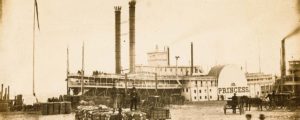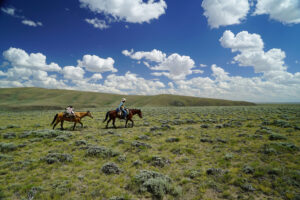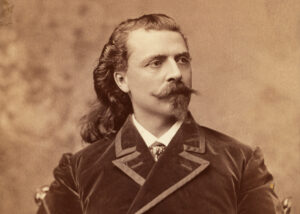It’s the place to recall the legendary cattle drive route.
Folks might wonder why the Chisholm Trail Heritage Center is in Oklahoma — Duncan is the seat of Stephens County, to be exact. Yes, the Chisholm Trail did begin in Texas, where the Longhorns were, and ended in Kansas, where the railheads were. But in between this most famous of the post– Civil War cattle trails passed through Indian Territory (present-day Oklahoma). While it’s also true that most of the activity on the Chisholm Trail occurred prior to the founding of Duncan in 1892, the trail did pass just to the east of the current city. Visitors to the center can see a section of the actual trail and check out relics of the cattle-drive era.
The Chisholm Trail is certainly worthy of commemoration. It played a historically significant role in the Wild West story, prompting formation of other cattle trails (e.g., the Western Trail and the Goodnight-Loving Trail) that together helped forge the enduring image of the American cowboy. The trail was named for trader Jesse Chisholm, who was born in Tennessee in 1806 to a Scottish father and Cherokee mother, and who by the late 1820s was living near Fort Gibson in what would become eastern Oklahoma. Chisholm soon established a series of trading posts, gaining a reputation as an honest dealer. Fluent in 14 dialects, he branched out as a guide and interpreter at various Indian treaty councils, including some in the Republic of Texas on behalf of his friend President Sam Houston. In the late 1850s he moved from the Cherokee Nation to the Creek Nation, then during the Civil War drifted to a post at the mouth of the Little Arkansas River, not far from present-day Wichita, Kan., serving both the Confederacy as a trader and the Union as an interpreter.
After the war Chisholm resumed trading in the nations and blazed a wagon trail from that post to the Red River. This trading trace became the Chisholm Trail and was first traversed by cattle in 1867 after Joseph G. McCoy encouraged Texas ranchers to drive their Longhorns to his newly built stockyards in Abilene, Kan. It is uncertain if Chisholm himself even knew about the first drive on the trail that would bear his name. He died of food poisoning on March 4, 1868, at a spring near present-day Geary, Okla.
From 1867 to 1871 Abilene was where most of the Texas cattle (some 3 million head) temporarily landed for shipment east by rail. As many as 5,000 cowboys were herding cattle on the Chisholm Trail in 1871 before other Kansas cow towns replaced Abilene in importance as railheads. As one historian observed, the Chisholm Trail was like a tree—the roots were the feeder trails from south Texas, the trunk was the main route from San Antonio across Indian Territory, and the branches were extensions to the Kansas railheads.
Texas cattlemen gave Chisholm’s name to the entire trail, from the Rio Grande north to central Kansas. Topeka’s Kansas Daily Commonwealth made one of the first references to the trail in May 1870, and the Daily News in Denton, Texas, described in its April 18, 1874, edition how cattle were moving up “the famous Chisholm Trail.” By the time the trail was about played out in 1884, cattlemen had used it to move more than 5 million cattle and 1 million mustangs—the greatest migration of livestock in American history.
The Chisholm Trail Heritage Center, established in 1998 and expanded in 2003, offers a “multisensory submersion” into the world of the cowboy drives as well as life on the southern Great Plains. It’s stated mission is “to celebrate and perpetuate the history, art and culture of the Chisholm Trail, the American cowboy and the American West.” Visitors will want to take in the trail documentary at the Chisholm Trail Experience Theater. Exhibits cover the art and science of cattle driving, branding, trailside wildlife, the chuck wagon and the romance of the trail through films and music. Western art aficionados will enjoy the Garis Gallery of the American West. And it’s impossible to miss Oklahoma native Paul Moore’s monumental bronze statue On the Chisholm Trail, which stretches almost 35 feet across the front lawn. For more information call 580-252-6692 or visit www .onthechisholmtrail.com.
Originally published in the April 2013 issue of Wild West. To subscribe, click here.




